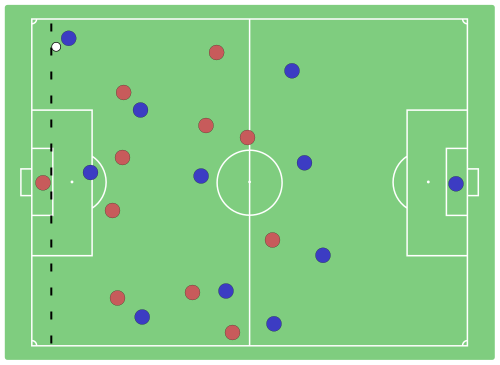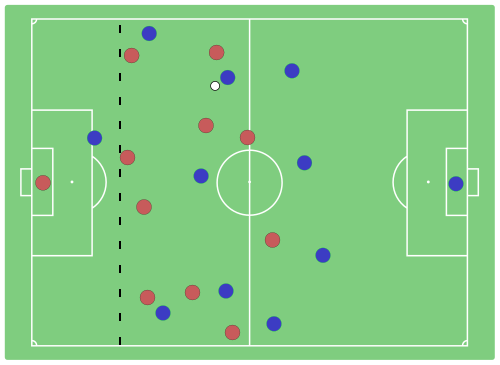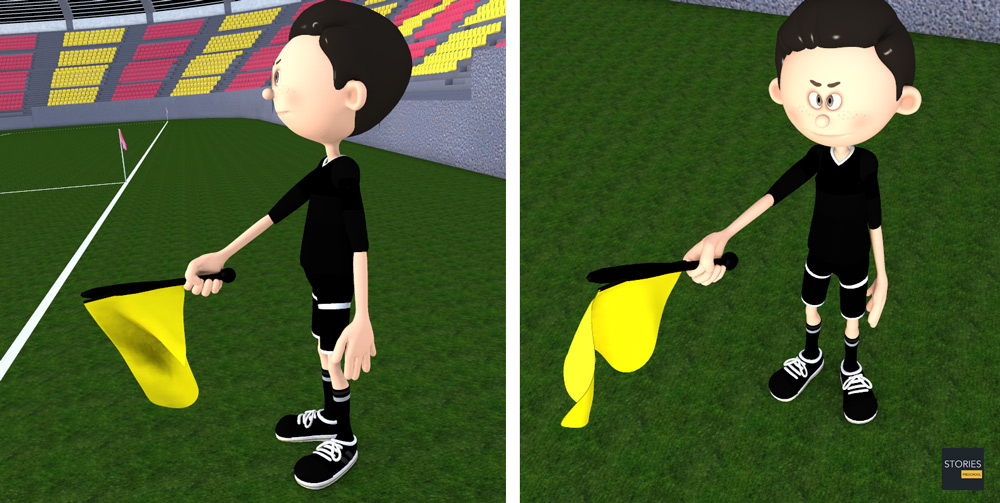Soccer

Soccer Offside
Offside is one of the laws of association football, codified in Law 11 of the Laws of the Game. The law states that players in an offside position, when the ball is touched or played by a teammate, may not become actively involved in the play. A player is in an offside position if any of their body parts with which they can touch the ball during any other part of the play is in the opponents' half of the pitch and closer to the opponents' goal line than both the ball and the second-to-last opponent (usually, but not necessarily always, the last defensive player in front of the goalkeeper). Being in an offside position is not an offense in itself; at the moment the ball touches, or is played by, the player's team, the player must also be "actively involved in the play" in the opinion of the referee, in order for an offense to occur. When the offside offense occurs, the referee stops play and awards an indirect free kick to the defending team from the position of the offending player.
The offside offense is neither a foul nor a misconduct, players are never booked or sent off for offside. Like fouls, however, any play (such as the scoring of a goal) that occurs after an offense has taken place but before the referee is able to stop the play is nullified. Players that continue such play may be booked based on the referee's assessment of how significant or intentional the play was.
One of the main duties of the assistant referees is to assist the referee in adjudicating offside — their position on the sidelines giving a more useful view sideways across the pitch. Assistant referees communicate that an offside offense has occurred by raising a signal flag. However, as with all officiating decisions in the game, adjudicating offside is ultimately up to the referee, who can overrule the advice of their assistants if they see fit.

The blue forward in the penalty box of the diagram is not in an offside position, as he is behind the ball, despite the fact that he is in front of all of his outfield opponents.
Application
The application of the offside rule may be considered in three steps: offside position, offside offense and offside sanction.
Offside Position
A player is in an offside position if he is in the opposing team's half of the field and is also "nearer to his opponents' goal line than both the ball and the second-last opponent." The 2005 edition of the Laws of the Game included a new IFAB decision that stated being "nearer to an opponent's goal line" meant that "any part of his head, body or feet is nearer to his opponents' goal line than both the ball and the second-last opponent". By the 2014/2015 Laws, the interpretation included the proviso that "The arms are not included in this definition".
In other words, a player is in an offside position if three conditions are met:
- The player is in the opposing team's half of the field.
- The player is closer to the opposing goal line than the ball is.
- There are one or zero opposing players between the player and the opposing goal line.
(The goalkeeper counts as an opposing player in the third condition, but it is not necessary that the last opponent be the goalkeeper.)
Regardless of position, there is no offside offense if a player receives the ball directly from a goal kick, a corner kick, or a throw-in. However, an offside offense may occur if a player receives the ball directly from either a direct free kick or an indirect free kick.

The blue forward on the left of the diagram is in an offside position as he is in front of both the second-to-last opponent (marked by the dotted line) and the ball. This does not necessarily mean he is committing an offside offense. It only becomes an offense if the ball is played while he is in an offside position and he subsequently interferes with play (such as receiving a pass), interferes with an opponent, or somehow gains an advantage by being in an offside position (such as receiving a deflected ball) no matter if any of these events occur after he moves to an onside position.
Offside Offense
A player in an offside position at the moment the ball is touched or played by a team mate is only committing an offside offense if, in the opinion of the referee, he becomes actively involved in play by:
- Interfering with Play: "playing or touching the ball passed or touched by a team-mate"
- Interfering with an Opponent: "preventing an opponent from playing or being able to play the ball by clearly obstructing the opponent’s line of vision or challenging an opponent for the ball"
- Gaining an Advantage by being in an Offside Position: "playing a ball that rebounds or is deflected to him off the goalpost, crossbar or an opponent having been in an offside position; or that rebounds, is deflected or is played to him from a deliberate save by an opponent having been in an offside position".
Since offside is judged at the time the ball is touched or played by a teammate, not when the player receives the ball, it is possible for a player to receive the ball significantly past the second-to-last opponent, or even the last opponent, without committing an offense.
Determining whether a player is in "active play" can be complex. The quote, "If you're not interfering with play, what are you doing on the pitch?" has been attributed to Brian Clough and Danny Blanchflower. FIFA issued new guidelines for interpreting the offside law in 2003 and these were incorporated in Law 11 in July 2005. The new wording seeks to define the three cases more precisely, but controversy regarding offside decisions often arises from assessment of what movements a player in an offside position can make without interfering with an opponent. This was further clarified by FIFA in 2015.
Offside Sanction
The restart for an offside sanction is an indirect free kick for the opponent at the place where the off-sided player was at the time the teammate passed or touched the ball. This is defined as where the infringement took place.
Officiating
In enforcing this rule, the referee depends greatly on an assistant referee, who generally keeps in line with the second-to-last opponent, the ball, or the halfway line, whichever is closer to the goal line of their relevant end. An assistant referee signals that an offside offense has occurred by first raising their flag upright without movement and then, when acknowledged by the referee, by raising their flag in a manner that signifies the location of the offense:
- Flag pointed at a 45-degree angle downwards: offense has occurred in the third of the pitch nearest to the assistant referee;
- Flag parallel to the ground: offense has occurred in the middle third of the pitch;
- Flag pointed at a 45-degree angle upwards: offense has occurred in the third of the pitch furthest from the assistant referee

The assistant referees' task with regard to offside can be difficult, as they need to keep up with attacks and counter-attacks, consider which players are in an offside position when the ball is played, and then determine whether and when the offside-positioned players become involved in active play. The risk of false judgement is further increased by the foreshortening effect, which occurs when the distance between the attacking player and the assistant referee is significantly different from the distance to the defending player, and the assistant referee is not directly in line with the defender. The difficulty of offside officiating is often underestimated by spectators. Trying to judge if a player is level with an opponent at the moment the ball is kicked is not easy: if an attacker and a defender are running in opposite directions, they can be two metres apart in less than a second.
Some researchers believe that offside officiating errors are "optically inevitable". It has been argued that human beings and technological media are incapable of accurately detecting an offside position quickly enough to make a timely decision. Sometimes it simply is not possible to keep all the relevant players in the visual field at once. There have been some proposals for automated enforcement of the offside rule.
SPORTS

RESOURCES
This article uses material from the Wikipedia articles "Association football" and "Offside (association football)", which is released under the Creative Commons Attribution-Share-Alike License 3.0.
© Stories Preschool. All Rights Reserved.












